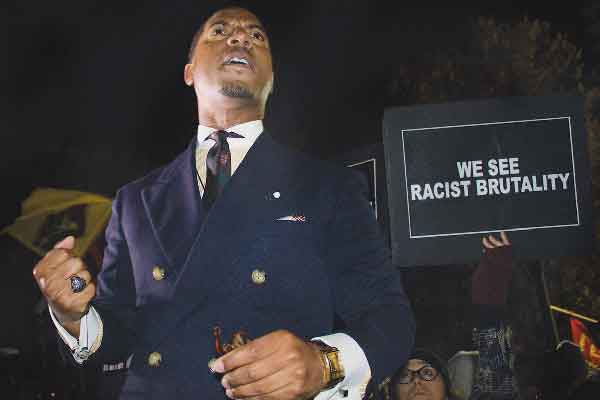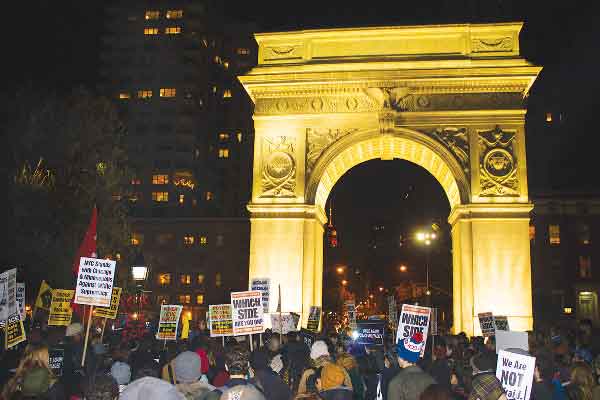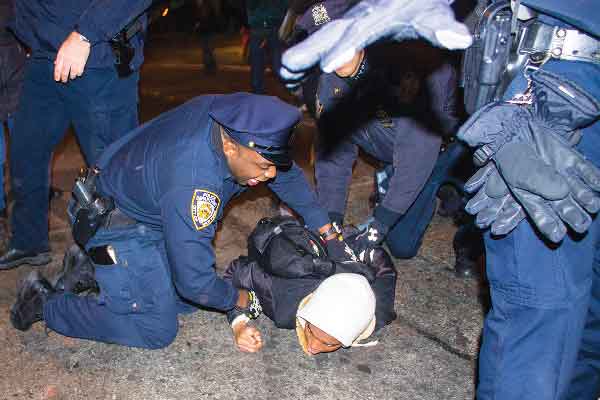
Preacher Richard Price told the marchers, “We’re worried about what’s going on — that black lives still don’t matter.”
BY ZACH WILLIAMS | Events a thousand miles away drove hundreds of #BlackLivesMatter activists out onto Manhattan’s streets last week.
People of color had once again been on the receiving end of a nationally prominent shooting. This time a group of white men in Minneapolis, Minnesota, allegedly shot five people who were part of ongoing protests sparked by the Nov. 15 fatal shooting there of 24-year-old Jamar Clark by police. Supporters quickly took the attack to be an attempt to stifle the one-year-old movement against police brutality and institutionalized racism.
In addition, a video of a police shooting in Chicago from last year was finally publicly released.
Supporters responded in New York City by highlighting their grievances in the most public way possible, by rallying, marching and chanting through the streets of Manhattan. A feeling of uncertainty shadowed a nighttime rally at Washington Square Park on Wed., Nov. 25. While reports of threats against the activists could not be confirmed, organizers acknowledged that new adversaries had emerged against their one-year-old movement.
“We refuse to be intimidated,” Vienna Rye, a Millions March NYC activist, told the crowd. “If they think these attacks will scare us away, let me just say they massively underestimate the power of the people.”
This opposition includes a segment of American society represented by West Side resident Donald Trump’s presidential campaign. Trump supporters at a Nov. 21 Alabama rally for the candidate attacked an activist who was chanting “Black Lives Matter” in the crowd.
Protests in New York City have been peaceful aside from sporadic scuffles with police at demonstrations. But that could change, said Josmar Trujillo of the Coalition to End Broken Windows.
“We are in a state of war. Self-defense is the minimum that we should be doing,” he told the protesters. “We need our communities because these mother—–rs are going to shoot at us… . It’s gotta be an escalation because this s— is escalating all around us.”

The collective power of several hundred activists depended that night on their success in evading the dozens of police officers who followed them, aided by a police helicopter and a cavalry of motorized scooters. In the West Village, the marchers briefly blocked streets until the police caught up. They repeated such efforts by making abrupt left or right turns when police moved forward during the march, all the while deploying a harsher rhetoric than seen in protests months ago.
They carried signs with slogans stating that police work hand in hand with the Ku Klux Klan, and their chants punctuated the accusations with profanity. The faces of people of color killed by police stared from photographs printed above words like “Justice” and the eponymous movement’s slogan, “BlackLivesMatter.”
There was little time for thinking when clashes would break out between the police and activists. Sometimes the activist invited arrest, such as when a member of the Chelsea-based Peoples Power Assemblies obstructed a policeman riding a scooter on St. Mark’s Place. The crowd rushed forward and police shoved them back.
Other times the police ventured into the crowd to track down an activist amid the tangle of bodies.
Pedestrians were relatively few on the cold autumn night, but a few raised their fists in solidarity, while most simply viewed the spectacle with a certain dismissiveness. Marchers banged on the windows of restaurants and urged patrons to join them. A young black man claimed victory when he convinced a young woman to utter “Black Lives Matter” as he passed.
That was what they said as they entered the Macy’s flagship store at Herald Square. There was nothing to stop them as they marched down the shopping aisles, but customers gave them little attention as they shopped the night before Thanksgiving. The police detail did not follow them into the store but was waiting on the other side, on Seventh Ave., when the protesters emerged there.

By then the crowd of a few hundred had dwindled by at least one-third. Those left continued the cat-and-mouse game with police until arriving at Times Square about four hours after the march’s start. It was there at the start of the demonstrations that a charismatic young preacher named Richard Price, of the Harlem Church of Christ, had addressed the crowd. He noted that many of them had participated in numerous local actions in the past year, but that progress continued to be slow.
During that time, a national debate on police and criminal justice reform began. But the events of November 2015 show that the overall goals of #BlackLivesMatter remain unfulfilled, Price said, adding that a disturbing phenomenon persists.
“For those who come here tonight saying that we’re just here because we want to hear ourselves: You have not been here when we marched all year long,” he said at the rally. “We’re worried about what’s going on. We’re worried that black lives still don’t matter. And so what I want to say is that this is a systemic thread woven through the fabric of our United States.”

















